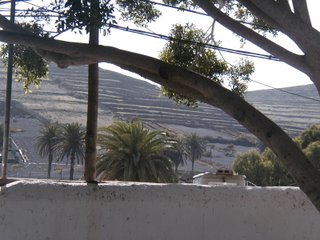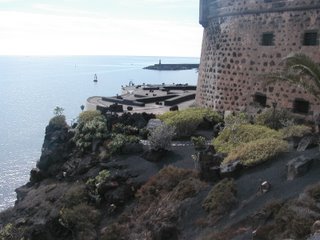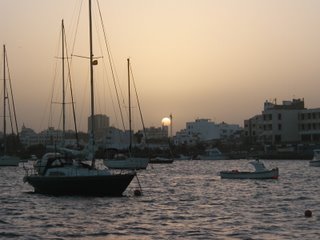Our time in Arrecife began with what we now think of as “Adventures in Anchoring”. The Puerto de Naos, tucked up at the southern end of Arrecife’s harbours, is one of the safest anchorages in the Canaries. Unlike most, it provides protection from all directions. It is also crowded with moorings, mostly occupied by smaller local boats, and has become a place of choice for cruisers settling in for a long term stay - two boats we were told had already been there for about a year, two others for two years. Then there were some abandoned boats, slowly deteriorating over time as they sat and rotated in tide and wind on their moorings. We dropped our anchor first in the only space we could see at the time, and spent too much time watching and worrying about how close we would swing to the boats moored near by.
So we took the first opportunity we could to move to a more open space among other boats swinging to anchors. We dropped the hook, and felt it grab, then stayed aboard for a couple of hours just to be sure. So imagine our horror when we came back from a trip ashore to find our boat rafted to another (rather bigger) one - and how profusely we thanked those aboard Tigress for corralling our dragging boat. Re-anchored, we sat aboard as the wind came up. Some hours into the blow, we could feel her moving again, so up with the anchor - and the two tyres which were attached to it. We tried reanchoring not far away, but were not satisfied that the anchor was holding - finally, we found a spot closer to moored boats than we liked - but at least the anchor was holding. And this time we were given very good advice by Trevor on Nergal - drop the anchor, but do not pull on it, the bottom being too soft - best to let the anchor sink by itself. We dropped and held, and in the morning decided our best chance was to swing like a moored boat. Two more anchors out, and we were finally in a spot we could stay in, and did for the next few weeks. But we never felt comfortable leaving Into The Blue for long.
Much of our time off the boat was spent walking around Arrecife. It is an interesting town, in the process of transition from a major fishing port to something else, a mix of tourist destination and business and government centre. Abandoned buildings where homeless people squat, the presence of beggars in the downtown commercial area, a profusion of graffiti - a few pictures and a lot of tagging - these and other things suggest that the transition is not an easy one. But we also found ourselves walking through beautifully landscaped and designed areas, enjoying the murals and sculptures we found along the streets and appreciating the very human scale of building we found here - only one high rise in the whole town and that a hotel. Much of what we enjoyed reflected the influence of one man, Cesar Manrique, and his supporters. And one of the places we most enjoyed in Arrecife was the Museo Internationale de Arte Contemporaneo in the Castillo de San Jose, a fort which was beautifully restored to house the museum under Manrique’s guidance.
We did take the time to travel by bus to Haria, a town in the northern part of Lanzarote. We had hoped to visit the Museo del Arte Sacre there, but found it closed for repairs. So we simply enjoyed the atmosphere of this town with its graceful public spaces and profusion of plants and its views of the surrounding hillsides with their terraces now only partly cultivated. On the drive to Haria we travelled through the hills, and saw the sloping fields covered with black lava pebbles with rows of bright green leaves growing through them. One field was being worked by two men guiding a small plough pulled by a mule. Occasionally we caught a glimpse of the coast from high above before we began the descent down a steep narrow road into the narrow roads of the town, roads not built for the kind of traffic they bear now. Our drive back took us along the coast roads a ways, before we turned back inland. And as we travelled we saw examples of Manrique’s influence - some of his wind toys, giant mobiles, in one of the roundabouts we passed, his former home which now houses the foundation he created, the cactus garden he designed - and these just a small part of the work he has done here. His work is so wide-ranging that you can only wonder at his ingenuity, creativity and strength.
Time, as it always seems to do, flew past. We did some work on the boat, and finally came to the point where we needed the facilities of Las Palmas - for the second time, we needed our radio fixed. So we left Arrecife and the Puerto de Naos, leaving behind its older men gathered mornings and evenings on the dock by the rescue boat and the pilot boat, spending their time watching the comings and goings in the harbour and enjoying their arguments and discussions. We left behind the few fishermen in their small local boats who still went out to fish - we often waved to them as they went past, and sometimes they even slowed down as they went past us - and they waved to us as we left. We learned from our friend Trevor that you can pull anchors up by dinghy as well as laying them out, and with his help we we retrieved anchors and set off on a cloudy morning for an overnight sail to Gran Canaria and the anchorage in Las Palmas.
The sail from Graciosa to Arrecife had been pleasant; a day sail with good enough winds to get us there in plenty of time to enter the harbour in daylight and find a spot to anchor. That must be why Mother Nature decided to make our sail to Las Palmas a little more eventful - starting with brisk winds, which then became stronger and on the nose, until shortly after midnight when they turned light and behind us. We went from reefed sails to as much sail as possible, and managed to get to Las Palmas shortly after dark the day after we set out, slightly battered and worn and glad to drop anchor and sleep. And now we have another city to explore, while we get ready for our trip across the Atlantic to the Caribbean.
 This is an early afternoon in the town square in Haria, in the north of the island. The area is one of the few in Lanzarote where the availability of water means that there is an abundance of trees and plants.
This is an early afternoon in the town square in Haria, in the north of the island. The area is one of the few in Lanzarote where the availability of water means that there is an abundance of trees and plants. Looking out from Haria toward slopes terraced for farming. Some of them are still cultivated, and where they are you can see the plants growing green against the black volcanic pebbles used to shelter the soil from sun and wind and conserve moisture.
Looking out from Haria toward slopes terraced for farming. Some of them are still cultivated, and where they are you can see the plants growing green against the black volcanic pebbles used to shelter the soil from sun and wind and conserve moisture. The view out to sea from the Modern Art Museum in the Castillo de San Jose, one of the spots we loved in Arrecife.
The view out to sea from the Modern Art Museum in the Castillo de San Jose, one of the spots we loved in Arrecife. Evening falls over the Charco de San Gines, the tidal sea water lagoon in the city of Arrecife where many of the smaller fishing boats and other local boats have their moorings. The church of San Gines is in the background.
Evening falls over the Charco de San Gines, the tidal sea water lagoon in the city of Arrecife where many of the smaller fishing boats and other local boats have their moorings. The church of San Gines is in the background. Art and daily life mix in the city of Arrecife, and some times the effects are odd...
Art and daily life mix in the city of Arrecife, and some times the effects are odd... While we were in Arrecife the East wind blew in clouds of sand from the Sahara. It filled the air with a reddish brown haze, hiding the nearby hills and creating a spectacularly different sunset.
While we were in Arrecife the East wind blew in clouds of sand from the Sahara. It filled the air with a reddish brown haze, hiding the nearby hills and creating a spectacularly different sunset.






